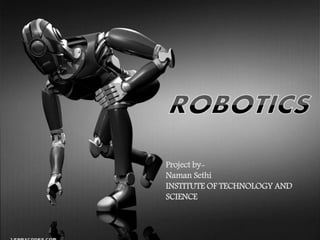
Roboticsprojectppt 130116183708-phpapp02
- 1. Project by- Naman Sethi INSTITUTE OF TECHNOLOGY AND SCIENCE
- 3. What is a Robot…? A re-programmable, multifunctional, automatic industrial machine designed to replace human in hazardous work. It can be used as :- •An automatic machine sweeper •An automatic car for a child to play with •A machine removing mines in a war field •In space •In military , and many more..
- 4. Robotics is science of designing or building an application of robots. Simply ,Robotics may be defines as “The Study of Robots”. The aim of robotics is to design an efficient robot. Robotics is needed because:- •Speed • Can work in hazardous/dangerous temperature • Can do repetitive tasks • Can do work with accuracy
- 6. The word robot was introduced to the public by Czech writer Karel Capek(1890-1938) in his play R.U.R. (Rossum's Universal Robots), published in 1920. The play begins in a factory that makes artificial people called robots . Capek was reportedly several times a candidate for the Nobel prize for his works . The word "robotics", used to describe this field of study, was coined accidentally by the Russian –born , American scientist and science fiction writer, Isaac Asimov(1920- 1992) in 1940s.
- 7. Asimov also proposed his three "Laws of Robotics", and he later added a “zeroth law”. Zeroth Law : A robot may not injure humanity, or, through inaction, allow humanity to come to harm First Law : A robot may not injure a human being, or, through inaction, allow a human being to come to harm, unless this would violate a higher order law Second Law: A robot must obey orders given it by human beings, except where such orders would conflict with a higher order law Third Law : A robot must protect its own existence as long as such protection does not conflict with a higher order law.
- 9. UNIMATE: • Unimate was the first industrial robot,[1] which worked on a General Motors assembly line at the Inland Fisher Guide Plant in Ewing Township, New Jersey, in 1961. • It was invented by George Devol in the 1950s using his original patent filed in 1954 and granted in 1961 (U.S. Patent 2,988,237). • The present invention relates to the automatic operation of machinery, particularly the handling apparatus, and to automatic control apparatus suited for such machinery.
- 10. Sensors Effectors Actuators Controllers Arms Most industrial robots have at least the following five parts:
- 11. Sensor Effector
- 12. Controller Arm
- 13. ` Types of Robots Mobile Robots The most common types of Robots are.. Autonomous Robots Virtual Robots Remote-Controlled Robots Stationary Robots
- 14. Mobile robots are of two types…. Rolling robots have wheels to move around. They can quickly and easily search. However they are only useful in flat areas. Robots on legs are usually brought in when the terrain is rocky. Most robots have at least 4 legs; usually they have 6 or more.
- 15. tonomous Robots are not only used to explore areas or imitate a human being. Most robots perform repeating tasks without ever moving an inch. Most robots are ‘working’ in industry settings and are stationary . Autonomous robots are self supporting or in other words self contained. In a way they rely on their own ‘brains’.
- 16. A person can guide a robot by remote control. A person can perform difficult and usually dangerous tasks without being at the spot where the tasks are performed. Virtual robots don’t exits In real life. Virtual robots are just programs, building blocks of software inside a computer.
- 17. Pros And Cons- Going to far away planets. Going far down into the unknown waters and mines where humans would be crushed Giving us information that humans can't get Working at places 24/7 without any salary and food. Plus they don't get bored They can perform tasks faster than humans and much more consistently and accurately Most of them are automatic so they can go around by themselves without any human interference. People can lose jobs in factories It needs a supply of power It needs maintenance to keep it running . It costs money to make or buy a robot